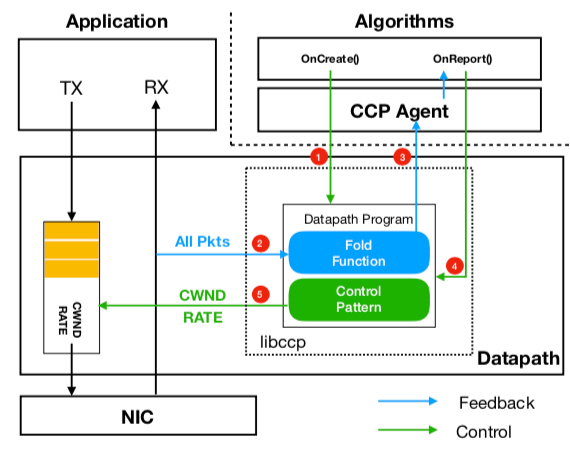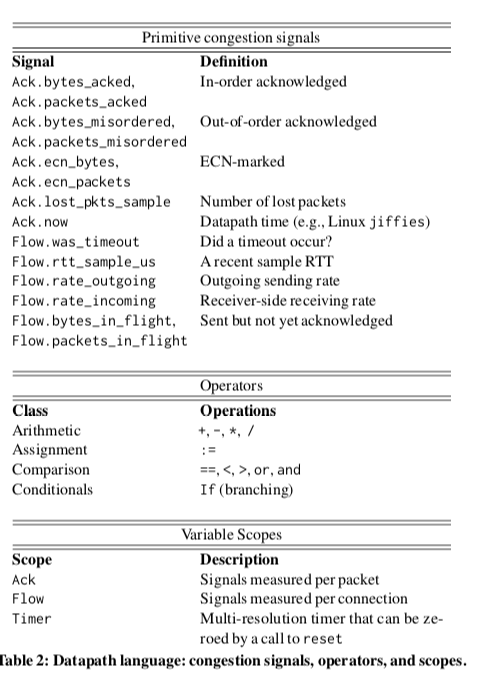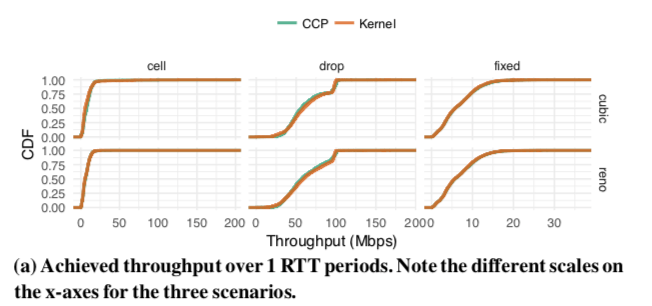Restructuring Endpoint Congestion Control
0x00 引言
这也是一篇比较有意思的Paper,主要讨论的是提出了Congestion Control Plane (CCP)的概念,希望能够实现Wirte-once,run-anywhere,以及可以容易在此的基础之上实现新的拥塞控制算法。CCP的设计中按照下面的设计原则,
- 数据面和拥塞控制隔离;
- 拥塞控制和ACK-clock分离,以一个周期报告ACK的信息,而不是每一个ACK报告一次;
- 可以数据面内实现对每一个ACK的逻辑。
CCP一个基本的架构如下,

0x01 使用CCP实现一个算法
CCP中主要使用的是onCreate和onReport两个回调处理函数。在一个流建立的时候数据面会调用这个onCreate的函数。这个函数会初始化一个数据面的程序。这个数据面的函数会计算出一些关于每个数据包的一些信息,这些信息会汇报给CCP agent。在report的时候,CCP agent调用onReport函数,这个函数根据这个函数计算出新的发送窗口的大小 or 发送速率。CCP的数据面程序使用一个简单的领域特定语言写成,根据每一个ACK来计算一些统计信息(control actions),一个简单的数据面程序,
(def (Report (volatile acked 0) (volatile lost 0)))
(when true
(:= Report.acked (+ Report.acked Ack.bytes_acked))
(:= Report.lost (+ Report.lost Ack.lost_pkts_sample)) (fallthrough))
(when (> Report.lost 0) (report))
这个DSL中包含的一些ACK的信息、一些Flow的信息,

CCP中的onReport()提供了在用户空间处理来自数据面数据的方法,一个简单的AIMD的算法实现的逻辑在onReport中实现如下,
def onReport(self, report):
if report["lost"] > 0:
self.cwnd = self.cwnd / 2
else:
acked = report["acked"]
self.cwnd = self.cwnd + acked*MSS/self.cwnd
self.update("cwnd", self.cwnd/MSS)
把数据面的DSL和CCP的两个Handler的实现组合在一起,下面是一个Slow Start的例子,
fn create(...) {
datapath.install("
(def (Report (volatile acked 0) (volatile loss 0)))
(when true
(:= Report.acked (+ Report.acked Ack.bytes_acked)))
(when (> Micros Flow.rtt_sample_us) (report) (reset))");
}
fn onReport(...) {
if report.get_field("Report.loss") == 0 {
let acked = report.get_field("Report.acked");
self.cwnd += acked;
datapath.update_field(&[("Cwnd", self.cwnd)]);
} else {
/* exit slow start */
}
}
0x02 实现
Paper中实现的CCP agent使用Rust语言实现,运行在用户空间之中。一个数据面实现了对CCP的支持之后,它就可以使用在CCP中实现的所有的算法。实现一个支持CCP的数据面要做下面的一些事情,
- 这个数据面应该要实现通过IPC与CCP agent通信的逻辑。数据面将多个的连接的信息通过一个IPC连接汇报给Agent;
- 这个数据应该执行一个用户定义的使用DSL编写成的一个程序,这个程序会在每一次收到ACK或者是超时的时候被调用。
由于要数据面要执行来自其它地方的代码,这里要注意处理就是安全问题和代码中出现的Bug等的问题,为此作者开发了一个libccp库,用于方便开发,
To use libccp, the datapath must provide callbacks to functions that: (1) set the window and rate, (2) provide a notion of time, and (3) send an IPC message to CCP. Upon reading a message from CCP, the datapath calls ccp_recv_msg(), which automatically de-multiplexes the message for the correct flow.
0x03 评估
这里的详细可以参看[1].

参考
- Restructuring Endpoint Congestion Control, SIGCOMM’18.
